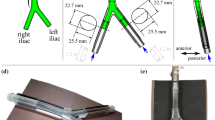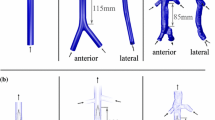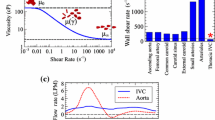Abstract
Purpose
The embolus trapping performance of inferior vena cava (IVC) filters critically depends on how emboli flow through the IVC and, thereby, on the underlying hemodynamics. Most previous studies of IVC hemodynamics have used computational fluid dynamics (CFD), but few have validated their results by comparing with quantitative experimental measurements of the flow field and none have validated in an anatomical model of the IVC that includes the primary morphological features that influence the hemodynamics (iliac veins, infrarenal curvature, and non-circular vessel cross-section). In this study, we perform verification and validation of CFD simulations in a patient-averaged anatomical model of the IVC.
Methods
Because we are most interested in the fluid dynamics that influence embolus transport and IVC filter embolus trapping, we focus our analyses on the velocity distribution and the amount of swirl and mixing in the infrarenal IVC. A rigorous mesh refinement study is first conducted at the highest flow rate condition to verify the computed solutions. To validate the CFD predictions of the flow patterns, we then compare with particle image velocimetry (PIV) data acquired in the same model in two planes (coronal and sagittal) within the infrarenal IVC at two flow rates corresponding to rest and exercise conditions.
Results
Using unstructured hexahedral meshes ranging in size from 800,000 to 102.5 million computational cells, we demonstrate that a coarse mesh may be used to resolve the gross flow patterns and velocity distribution in the IVC. A finer mesh is, however, required to obtain asymptotic mesh convergence of swirl and mixing in the IVC, as quantified by the local normalized helicity, LNH, and the volume-averaged helicity intensity, \(\overline{HI}\). Based on the results of the mesh refinement study, we use a moderately fine mesh containing approximately 26 million cells for comparison with experimental data. The validation study demonstrates excellent qualitative agreement between CFD predictions and PIV measurements of the velocity field at both conditions. Quantitatively, we show that the global relative comparison error, E, between CFD and PIV ranges from 3 to 11%. By performing sensitivity studies, we demonstrate that the quantitative discrepancy is attributable to a combination of uncertainty in the inlet flow rates and uncertainty associated with precisely aligning the PIV data with the CFD geometry.
Conclusions
Overall, the study demonstrates mesh-convergent CFD simulations that predict IVC flow patterns that agree reasonably well with PIV data, even at exercise conditions where the flow in the IVC is extremely complex.










Similar content being viewed by others
References
ASME V&V 20-2009. Standard for verfication and validation in computational fluid dynamics and heat transfer. American Society of Mechanical Engineers, 2016
ASME V&V 40-2018. Assessing credibility of computational modeling through verification and validation: application to medical devices. American Society of Mechanical Engineers, 2018
Aycock, K. I., R. L. Campbell, K. B. Manning, S. P. Sastry, S. M. Shontz, F. C. Lynch, and B. A. Craven. A computational method for predicting inferior vena cava filter performance on a patient-specific basis. J. Biomech. Eng. 136(081):003, 2014.
Aycock, K. I., R. L. Campbell, F. C. Lynch, K. B. Manning, and B. A. Craven. The importance of hemorheology and patient anatomy on the hemodynamics in the inferior vena cava. Ann. Biomed. Eng. 44(12):3568–3582, 2016.
Aycock, K. I., R. L. Campbell, F. C. Lynch, K. B. Manning, and B. A. Craven. Computational predictions of the embolus-trapping performance of an IVC filter in patient-specific and idealized IVC geometries. Biomech. Model. Mechanobiol. 16:1957–1969, 2017a. https://doi.org/10.1007/s10237-017-0931-5.
Aycock, K. I., R. L. Campbell, K. B. Manning, and B. A. Craven. A resolved two-way coupled CFD/6-DOF approach for predicting embolus transport and the embolus-trapping efficiency of IVC filters. Biomech. Model. Mechanobiol. 16(3):851–869, 2017b. https://doi.org/10.1007/s10237-016-0857-3.
Aycock, K. I., P. Hariharan, and B. A. Craven. Particle image velocimetry measurements in an anatomical vascular model fabricated using inkjet 3D printing. Exp. Fluids 58(11):154, 2017c. https://doi.org/10.1007/s00348-017-2403-1.
Caplin, D. M., B. Nikolic, S. P. Kalva, S. Ganguli, W. E. Saad, and D. A. Zuckerman. Quality improvement guidelines for the performance of inferior vena cava filter placement for the prevention of pulmonary embolism. J. Vasc. Interv. Radiol. 14:S271–S275, 2011. https://doi.org/10.1016/j.jvir.2011.07.012.
Chiastra, C., S. Morlacchi, D. Gallo, U. Morbiducci, R. Cardenes, I. Larrabide, and F. Migliavacca. Computational fluid dynamic simulations of image-based stented coronary bifurcation models. J. R. Soc. Interface 10(84):20130193–20130193, 2013. https://doi.org/10.1098/rsif.2013.0193.
Choudhary, A., I. T. Voyles, C. J. Roy, W. L. Oberkampf, and M. Patil. Probability bounds analysis applied to the Sandia verification and validation challenge problem. J. Verif. Valid. Uncertain. Quantif. 1(1):011003, 2016. https://doi.org/10.1115/1.4031285.
Gallagher, M., K. Aycock, B. Craven, and K. Manning. Steady flow in a patient-averaged inferior vena cava—part I: particle image velocimetry measurements at rest and exercise conditions. Cardiovasc. Eng. Technol. 2018. https://doi.org/10.1007/s13239-018-00390-2.
Gallo, D., D. A. Steinman, P. B. Bijari, and U. Morbiducci. Helical flow in carotid bifurcation as surrogate marker of exposure to disturbed shear. J. Biomech. 45(14):2398–2404, 2012. https://doi.org/10.1016/j.jbiomech.2012.07.007.
Hariharan, P., K.I. Aycock, M. Buesen, S.W. Day, B.C. Good, L.H. Herbertson, U. Steinseifer, K.B. Manning, B.A. Craven, and R.A. Malinauskas. Inter-laboratory characterization of the velocity field in the FDA blood pump model using particle image velocimetry (PIV). Cardiovasc. Eng. Technol. 2018. https://doi.org/10.1007/s13239-018-00378-y
López, J.M., G. Fortuny, D. Puigjaner, J. Herrero, and F. Marimon. A comparative CFD study of four inferior vena cava filters. Int. J. Numer. Methods Biomed. Eng. e2990, 2018. https://doi.org/10.1002/cnm.2990
Malinauskas, R. A., P. Hariharan, S. W. Day, L. H. Herbertson, M. Buesen, U. Steinseifer, K. I. Aycock, B. C. Good, S. Deutsch, K. B. Manning, and B. A. Craven. FDA benchmark medical device flow models for CFD validation. ASAIO J. 63(2):150–160, 2017.
Moffatt, H., and A. Tsinober. Helicity in laminar and turbulent flow. Annu. Rev. Fluid Mech. 24(1):281–312, 1992.
Moffatt, H. K. The degree of knottedness of tangled vortex lines. J. Fluid Mech. 35(1):117–129, 1969.
Morbiducci, U., R. Ponzini, G. Rizzo, M. Cadioli, A. Esposito, F. De Cobelli, A. Del Maschio, F. M. Montevecchi, and A. Redaelli. In vivo quantification of helical blood flow in human aorta by time-resolved three-dimensional cine phase contrast magnetic resonance imaging. Ann. Biomed. Eng. 37(3):516–531, 2008. https://doi.org/10.1007/s10439-008-9609-6.
Mukherjee, D., J. Padilla, and S. C. Shadden. Numerical investigation of fluid–particle interactions for embolic stroke. Theor. Comput. Fluid Dyn. 30(1–2):23–39, 2016.
Najjari, M.R., J.A. Hinke, K.V. Bulusu, and M.W. Plesniak. On the rheology of refractive-index-matched, non-Newtonian blood-analog fluids for PIV experiments. Exp. Fluids 57(6), 2016. https://doi.org/10.1007/s00348-016-2185-x
Nicolás, M., V. Palero, E. Peña, M. Arroyo, M. Martínez, and M. Malvè. Numerical and experimental study of the fluid flow through a medical device. Int. Commun. Heat Mass Transf. 61:170–178, 2015. https://doi.org/10.1016/j.icheatmasstransfer.2014.12.013.
Oberkampf, W. L., and C. J. Roy. Verification and Validation in Scientific Computing. Cambridge: Cambridge University Press, 2010.
Rahbar, E., D. Mori, and J. Moore, Jr. Three-dimensional analysis of flow disturbances caused by clots in inferior vena cava filters. J. Vasc. Int. Radiol 22:835–842, 2011.
Ren, Z., S. L. Wang, and M. A. Singer. Modeling hemodynamics in an unoccluded and partially occluded inferior vena cava under rest and exercise conditions. Med. Biol. Eng. Comput. 50(3):277–287, 2012. https://doi.org/10.1007/s11517-012-0867-y.
Roach, M. R., S. Scott, and G. G. Ferguson. The hemodynamic importance of the geometry of bifurcations in the circle of Willis (glass model studies). Stroke 3(3):255–267, 1972.
Roache, P. J. Perspective: a method for uniform reporting of grid refinement studies. J. Fluids Eng. 116(3):405–413, 1994.
Roache, P. J. Quantification of uncertainty in computational fluid dynamics. Annu. Rev. Fluid Mech. 29(1):123–160, 1997.
Roache, P. J. Fundamentals of Verification and Validation. Socorro, NM: Hermosa Publishers, 2009.
Roache, P. J. Verification and validation in fluids engineering: some current issues. J. Fluids Eng. 138(10):101205, 2016. https://doi.org/10.1115/1.4033979.
Roy, C. J., and W. L. Oberkampf. A comprehensive framework for verification, validation, and uncertainty quantification in scientific computing. Comput. Methods Appl. Mech. Eng. 200(25–28):2131–2144, 2011. https://doi.org/10.1016/j.cma.2011.03.016.
Shtilman, L., E. Levich, S. A. Orszag, R. B. Pelz, and A. Tsinober. On the role of helicity in complex fluid flows. Phys. Lett. A 113(1):32–37, 1985.
Singer, M. A., W. D. Henshaw, and S. L. Wang. Computational modeling of blood flow in the TrapEase inferior vena cava filter. J. Vasc. Interv. Radiol. 20(6):799–805, 2009. https://doi.org/10.1016/j.jvir.2009.02.015.
Singer, M. A., and S. L. Wang. Modeling blood flow in a tilted inferior vena cava filter: Does tilt adversely affect hemodynamics? J. Vasc. Interv. Radiol. 22(2):229–235, 2011. https://doi.org/10.1016/j.jvir.2010.09.032.
Singer, M. A., S. L. Wang, and D. P. Diachin. Design optimization of vena cava filters: An application to dual filtration devices. J. Biomech. Eng. 132(10):101006, 2010. https://doi.org/10.1115/1.4002488.
Sotelo, J., J. Urbina, I. Valverde, J. Mura, C. Tejos, P. Irarrazaval, M. E. Andia, D. E. Hurtado, and S. Uribe. Three-dimensional quantification of vorticity and helicity from 3D cine PC-MRI using finite-element interpolations. Magn. Reson. Med. 79(1):541–553, 2018. https://doi.org/10.1002/mrm.26687.
Stewart, S. F. C., R. A. Robinson, R. A. Nelson, and R. A. Malinauskas. Effects of thrombosed vena cava filters on blood flow: flow visualization and numerical modeling. Ann. Biomed. Eng. 36(11):1764–1781, 2008. https://doi.org/10.1007/s10439-008-9560-6.
Swaminathan, T., H. H. Hu, and A. A. Patel. Numerical analysis of the hemodynamics and embolus capture of a Greenfield vena cava filter. J. Biomech. Eng. 128(3):360–370, 2006.
Tedaldi, E., C. Montanari, K. I. Aycock, F. Sturla, A. Redaelli, and K. B. Manning. An experimental and computational study of the inferior vena cava hemodynamics under respiratory-induced collapse of the infrarenal IVC. Med. Eng. Phys. 54:44–55, 2018. https://doi.org/10.1016/j.medengphy.2018.02.003.
Wang, S. L., and M. A. Singer. Toward an optimal position for inferior vena cava filters: computational modeling of the impact of renal vein inflow with Celect and TrapEase filters. J. Vasc. Interv. Radiol. 21(3):367–374, 2010. https://doi.org/10.1016/j.jvir.2009.11.013.
Yap, C. H., X. Liu, and K. Pekkan. Characterizaton of the vessel geometry, flow mechanics and wall shear stress in the great arteries of wildtype prenatal mouse. PLoS ONE 9(1):e86878, 2014. https://doi.org/10.1371/journal.pone.0086878.
Acknowledgments
We thank Joshua Soneson and Tina Morrison for reviewing the manuscript. This study was funded by the U.S. FDA Center for Devices and Radiological Health (CDRH) Critical Path program. The research was supported in part by an appointment to the Research Participation Program at the U.S. FDA administered by the Oak Ridge Institute for Science and Education through an interagency agreement between the U.S. Department of Energy and FDA. The simulations were performed using the computational resources of the high-performance computing clusters at the U.S. FDA. The findings and conclusions in this article have not been formally disseminated by the FDA and should not be construed to represent any agency determination or policy. The mention of commercial products, their sources, or their use in connection with material reported herein is not to be construed as either an actual or implied endorsement of such products by the Department of Health and Human Services.
Conflict of interest
B. A. Craven, K. I. Aycock, and K. B. Manning declare that they have no conflict of interest.
Ethical Approval
No human studies were carried out by the authors for this article. No animal studies were carried out by the authors for this article.
Author information
Authors and Affiliations
Corresponding author
Additional information
Associate Editors Dr. David A. Steinman, Dr. Francesco Migliavacca, and Dr. Ajit P. Yoganathan oversaw the review of this article.
Rights and permissions
About this article
Cite this article
Craven, B.A., Aycock, K.I. & Manning, K.B. Steady Flow in a Patient-Averaged Inferior Vena Cava—Part II: Computational Fluid Dynamics Verification and Validation. Cardiovasc Eng Tech 9, 654–673 (2018). https://doi.org/10.1007/s13239-018-00392-0
Received:
Accepted:
Published:
Issue Date:
DOI: https://doi.org/10.1007/s13239-018-00392-0




